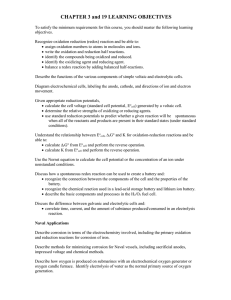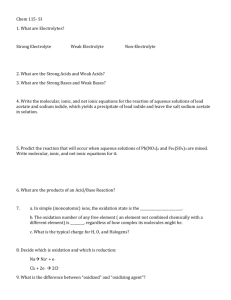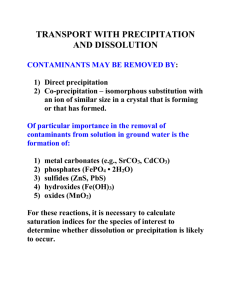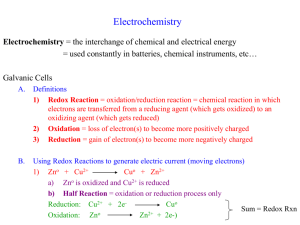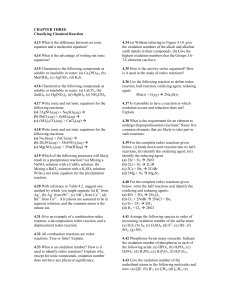Electrochemistry Assignment: Redox, Cells, Electrolysis
advertisement
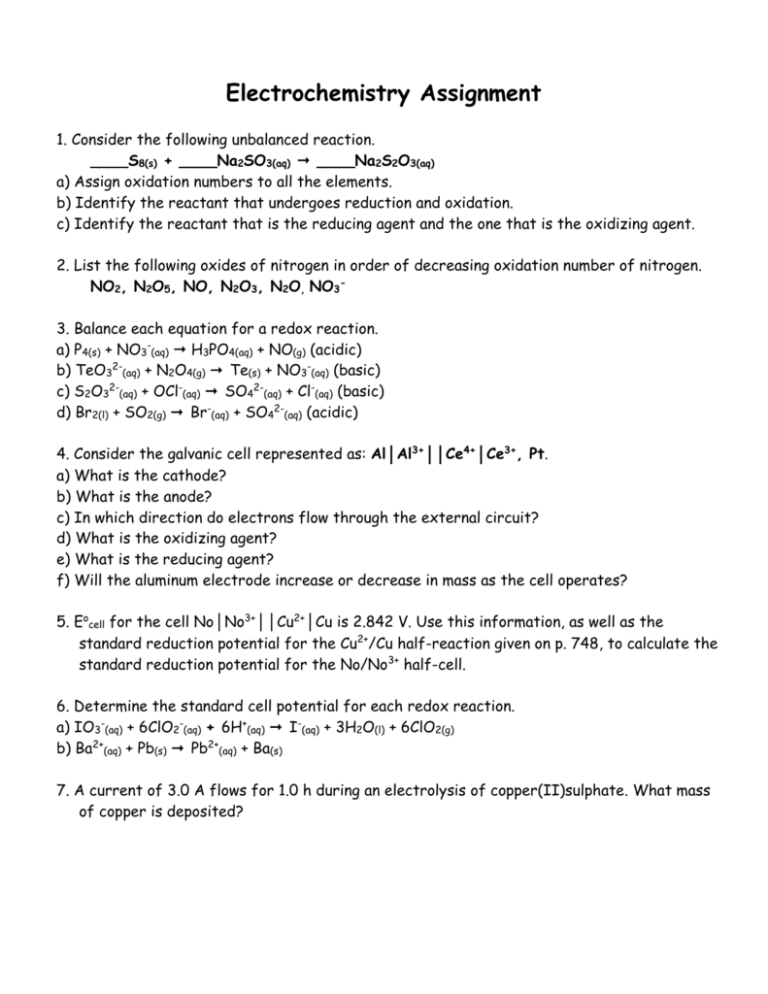
Electrochemistry Assignment 1. Consider the following unbalanced reaction. ____S8(s) + ____Na2SO3(aq) ____Na2S2O3(aq) a) Assign oxidation numbers to all the elements. b) Identify the reactant that undergoes reduction and oxidation. c) Identify the reactant that is the reducing agent and the one that is the oxidizing agent. 2. List the following oxides of nitrogen in order of decreasing oxidation number of nitrogen. NO2, N2O5, NO, N2O3, N2O, NO33. Balance each equation for a redox reaction. a) P4(s) + NO3-(aq) H3PO4(aq) + NO(g) (acidic) b) TeO32-(aq) + N2O4(g) Te(s) + NO3-(aq) (basic) c) S2O32-(aq) + OCl-(aq) SO42-(aq) + Cl-(aq) (basic) d) Br2(l) + SO2(g) Br-(aq) + SO42-(aq) (acidic) 4. Consider the galvanic cell represented as: Al│Al3+││Ce4+│Ce3+, Pt. a) What is the cathode? b) What is the anode? c) In which direction do electrons flow through the external circuit? d) What is the oxidizing agent? e) What is the reducing agent? f) Will the aluminum electrode increase or decrease in mass as the cell operates? 5. Eocell for the cell No│No3+││Cu2+│Cu is 2.842 V. Use this information, as well as the standard reduction potential for the Cu2+/Cu half-reaction given on p. 748, to calculate the standard reduction potential for the No/No3+ half-cell. 6. Determine the standard cell potential for each redox reaction. a) IO3-(aq) + 6ClO2-(aq) + 6H+(aq) I-(aq) + 3H2O(l) + 6ClO2(g) b) Ba2+(aq) + Pb(s) Pb2+(aq) + Ba(s) 7. A current of 3.0 A flows for 1.0 h during an electrolysis of copper(II)sulphate. What mass of copper is deposited? Electrochemistry Assignment 1. Consider the following unbalanced reaction. ____S8(s) + ____Na2SO3(aq) ____Na2S2O3(aq) a) Assign oxidation numbers to all the elements. b) Identify the reactant that undergoes reduction and oxidation. c) Identify the reactant that is the reducing agent and the one that is the oxidizing agent. 2. List the following oxides of nitrogen in order of decreasing oxidation number of nitrogen. NO2, N2O5, NO, N2O3, N2O, NO33. Balance each equation for a redox reaction. a) P4(s) + NO3-(aq) H3PO4(aq) + NO(g) (acidic) b) TeO32-(aq) + N2O4(g) Te(s) + NO3-(aq) (basic) c) S2O32-(aq) + OCl-(aq) SO42-(aq) + Cl-(aq) (basic) d) Br2(l) + SO2(g) Br-(aq) + SO42-(aq) (acidic) 4. Consider the galvanic cell represented as: Al│Al3+││Ce4+│Ce3+, Pt. a) What is the cathode? b) What is the anode? c) In which direction do electrons flow through the external circuit? d) What is the oxidizing agent? e) What is the reducing agent? f) Will the aluminum electrode increase or decrease in mass as the cell operates? 5. Eocell for the cell No│No3+││Cu2+│Cu is 2.842 V. Use this information, as well as the standard reduction potential for the Cu2+/Cu half-reaction given on p. 748, to calculate the standard reduction potential for the No/No3+ half-cell. 6. Determine the standard cell potential for each redox reaction. a) IO3-(aq) + 6ClO2-(aq) + 6H+(aq) I-(aq) + 3H2O(l) + 6ClO2(g) b) Ba2+(aq) + Pb(s) Pb2+(aq) + Ba(s) 7. A current of 3.0 A flows for 1.0 h during an electrolysis of copper(II)sulphate. What mass of copper is deposited?

